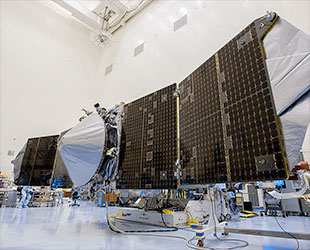September 22, 2014 – For just the twelfth time in history, a spacecraft has entered orbit around Mars.
NASA's MAVEN, which is short for Mars Atmosphere and Volatile Evolution, entered Mars' orbit Sunday night (Sept. 21) at 10:24 p.m. EDT (0224 GMT Sept. 22), where it will now prepare to study the Red Planet's upper atmosphere as never done before. MAVEN is the first probe dedicated to exploring the tenuous upper atmosphere of Mars.
"Congratulations, MAVEN is now in Mars orbit!" navigation chief David Folta at NASA's Goddard Space Flight Center in Maryland announced to cheers from the mission's flight control team.
After a 10-month journey, confirmation of orbital insertion was received from data observed at the Lockheed Martin operations center in Colorado, as well as from the tracking data monitored at NASA's Jet Propulsion Laboratory (JPL) navigation facility in Pasadena, California. MAVEN, which was launched Nov. 18, 2013 from the Cape Canaveral AIr Force Station in Florida, fired a 34-minute, six-engine burn to slow its approach, letting Mars' gravity pull it into orbit.

MAVEN team members at Lockheed Martin's operations center in Littleton, Colorado celebrate after receiving confirmation that the spacecraft entered Mars' orbit on Sept. 21. (Lockheed Martin) |
"NASA has a long history of scientific discovery at Mars and the safe arrival of MAVEN opens another chapter," said John Grunsfeld, a former astronaut and the associate administrator of the NASA Science Mission Directorate at NASA Headquarters. "MAVEN will complement NASA's other Martian robotic explorers – and those of our partners around the globe – to answer some fundamental questions about Mars and life beyond Earth."
One Earth-year primary mission
MAVEN now begins a six-week commissioning phase that includes maneuvering into a final science orbit and testing instruments and science-mapping commands. The probe will then begin its one Earth-year primary mission, taking measurements of the composition, structure and escape of gases in Mars' atmosphere and its interaction with the sun and solar wind.
"It's taken 11 years from the original [mission] concept for MAVEN to now having a spacecraft in orbit at Mars," said Bruce Jakosky, principal investigator for MAVEN with the Laboratory for Atmospheric and Space Physics (LASP) at the University of Colorado in Boulder. "I'm delighted to be here safely and successfully, and look forward to starting our science mission."

NASA's MAVEN spacecraft is seen with its gull-wing solar panels deployed, Sept. 30, 2013. (LaunchPhotography.com/Ben Cooper) |
The mission includes five "deep-dip" campaigns, in which MAVEN's periapsis, or lowest orbit altitude, will be lowered from 93 to about 77 miles (150 to 125 kilometers). These measurements will provide information down to where the upper and lower atmospheres meet, giving scientists a full profile of the upper tier.
"This was a very big day for MAVEN," David Mitchell, the mission's project manager from NASA Goddard, said. "We are very excited to join the constellation of spacecraft in orbit at Mars and on the surface of the Red Planet. The commissioning phase will keep the operations team busy for the next six weeks, and then we will begin, at last, the science phase of the mission."
Earlier missions have shown that Mars once had a denser atmosphere, which supported liquid water on the surface. Features such as dry channels and minerals that typically form in water have provided a record of the planet's watery past, but its thin atmosphere no longer permits water to be stable at the surface.

Artist concept of NASA's Mars Atmosphere and Volatile EvolutioN (MAVEN) mission in orbit over the Red Planet. (NASA/GSFC) |
MAVEN will study how and at what rate Mars' atmospheric gases are being lost to space today, enabling scientists to infer what happened in the planet's past. Studying how the atmosphere was lost will lead to a better understanding of the impact that change had on Mars' climate, geologic and geochemical conditions, all of which contribute to whether Mars had an environment capable of supporting life.
"As the first orbiter dedicated to studying Mars' upper atmosphere, Maven will greatly improve our understanding of the history of the Martian atmosphere, how the climate has changed over time, and how that has influenced the evolution of the surface and the potential habitability of the planet," said NASA Administrator Charles Bolden. "It also will better inform a future mission to send humans to the Red Planet in the 2030s."
Joining the Martian fleet
In addition to its payload of science instruments, MAVEN also carries Electra, a high-frequency transceiver. Electra will serve as a backup communications relay for NASA's Curiosity and Opportunity rovers, which landed on Mars in 2004 and 2012, respectively.
The rovers are able to return more data to Earth through a relay than they could with direct-to-Earth communications. NASA's earlier-deployed orbiters Mars Odyssey and Mars Reconnaissance Orbiter currently provide the rovers' relay services.

Insignia for the Mars Atmosphere and Volatile Evolution (MAVEN) mission to study the Red Planet's upper atmosphere. (NASA) |
MAVEN is now the fourth active spacecraft in Mars' orbit. Also at the Red Planet is Europe's Mars Express probe.
MAVEN is the tenth spacecraft that the United States has sent to circle Mars, including three that failed. NASA's and the world's first probe to enter Martian orbit was Mariner 9 in November 1971.
Russia also succeeded in sending four spacecraft to orbit Mars, most recently in 1989. India's Mars Orbiter Mission (MOM) is also set to arrive in orbit on Tuesday (Sept. 23).
